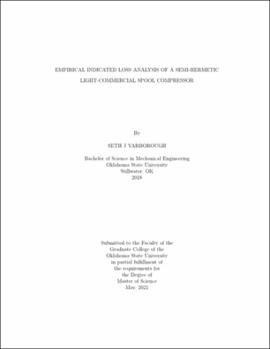| dc.contributor.advisor | Bradshaw, Craig | |
| dc.contributor.author | Yarborough, Seth J. | |
| dc.date.accessioned | 2021-09-23T19:51:48Z | |
| dc.date.available | 2021-09-23T19:51:48Z | |
| dc.date.issued | 2021-05 | |
| dc.identifier.uri | https://hdl.handle.net/11244/330858 | |
| dc.description.abstract | An analysis of the indicated losses is presented for a semi-hermetic, light-commercial, prototype, spool compressor. The spool compressor prototype was instrumented with five high-speed pressure sensors, three in the compression process, one in the discharge valve plenum, and one in the motor cavity. These sensors were triggered with a proximity sensor actuated by means of a custom rotary fixture attached to the compressor motor shaft. This coupling of rotational position and pressure measurements allowed the development of an indicator (pressure v. volume) diagram for the compression process. Additionally, the added sensor in the discharge valve plenum allowed for a de-coupling of discharge valve losses and flow losses within the discharge plenum itself. The sensor in the motor cavity allowed for an analysis of the flow losses leaving the compressor shell. The compressor was tested at five motor speeds (1100, 1300, 1500, 1700 rpm and line voltage) at condensing and evaporating temperatures ranging from 37.8-48.9 degrees C (90 - 130 degrees F) and -3.8 - 15.6 degrees C (30 -60 degrees F), respectively at a fixed suction superheat of 20 degrees R (11.1 K). Quantitative analysis shows that the suction and compression losses for this prototype compressor are relatively small compared with the discharge/valve losses. The total losses during the discharge process are generated by pressure drop and back flow through the discharge valve ports as well as when gas flows from the discharge plenum to out of the compressor body. It was found that a 5-6% compressor efficiency can be accomplished by redesigning the discharge plenum and motor cavity to reduce over pressurization. Further investigation into the valve dynamics need to be performed to improve the 11-12% loss in the valves. There is little dependence on operating condition for losses presented while the discharge losses tend to increase with and increasing speed and decreasing SDT. The work presented in this thesis is part of a broader initiative to improve the performance and functionality of the spool compressor specifically for low-GWP refrigerants. | |
| dc.format | application/pdf | |
| dc.language | en_US | |
| dc.rights | Copyright is held by the author who has granted the Oklahoma State University Library the non-exclusive right to share this material in its institutional repository. Contact Digital Library Services at lib-dls@okstate.edu or 405-744-9161 for the permission policy on the use, reproduction or distribution of this material. | |
| dc.title | Empirical indicated loss analysis of a semi-hermetic light-commercial spool compressor | |
| dc.contributor.committeeMember | Fisher, Daniel | |
| dc.contributor.committeeMember | Bai, He | |
| osu.filename | Yarborough_okstate_0664M_17062.pdf | |
| osu.accesstype | Open Access | |
| dc.type.genre | Thesis | |
| dc.type.material | Text | |
| dc.subject.keywords | compressor testing | |
| dc.subject.keywords | indicated loss | |
| dc.subject.keywords | pressure trace | |
| dc.subject.keywords | spool compressor | |
| thesis.degree.discipline | Mechanical and Aerospace Engineering | |
| thesis.degree.grantor | Oklahoma State University | |
